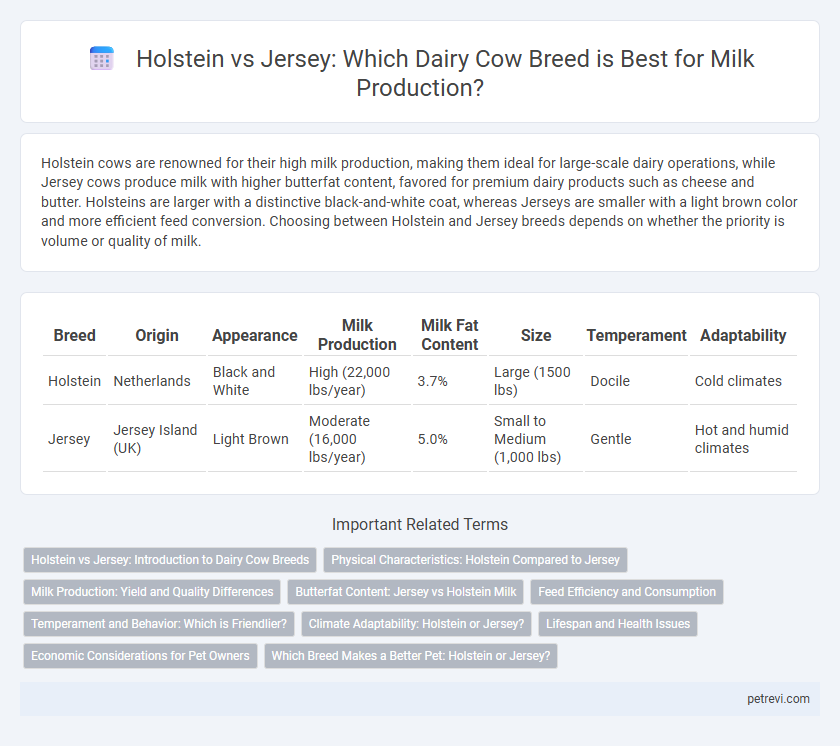Holstein cows are renowned for their high milk production, making them ideal for large-scale dairy operations, while Jersey cows produce milk with higher butterfat content, favored for premium dairy products such as cheese and butter. Holsteins are larger with a distinctive black-and-white coat, whereas Jerseys are smaller with a light brown color and more efficient feed conversion. Choosing between Holstein and Jersey breeds depends on whether the priority is volume or quality of milk.
Table of Comparison
| Breed | Origin | Appearance | Milk Production | Milk Fat Content | Size | Temperament | Adaptability |
|---|---|---|---|---|---|---|---|
| Holstein | Netherlands | Black and White | High (22,000 lbs/year) | 3.7% | Large (1500 lbs) | Docile | Cold climates |
| Jersey | Jersey Island (UK) | Light Brown | Moderate (16,000 lbs/year) | 5.0% | Small to Medium (1,000 lbs) | Gentle | Hot and humid climates |
Holstein vs Jersey: Introduction to Dairy Cow Breeds
Holstein cows are renowned for their high milk production, averaging 22,000 pounds of milk per lactation with a lower butterfat content of about 3.7%, making them ideal for volume-driven dairy operations. Jersey cows produce less milk, around 13,000 pounds per lactation, but their milk contains a higher butterfat content of approximately 5%, which is preferred for cheese and butter production. The choice between Holstein and Jersey breeds depends on farm goals, whether prioritizing quantity or milk quality and richness.
Physical Characteristics: Holstein Compared to Jersey
Holsteins are typically larger, weighing around 1,500 pounds with a height of 58 inches, and exhibit distinctive black and white markings, while Jerseys are smaller, averaging 1,000 pounds and 50 inches tall, with a solid light brown or fawn coat. Holsteins have a more angular, taller frame, ideal for high milk production, whereas Jerseys possess a compact, refined build that contributes to their rich, high-butterfat milk. The significant size difference and distinct coloration make Holsteins easily recognizable compared to the more petite and uniformly colored Jerseys.
Milk Production: Yield and Quality Differences
Holstein cows are renowned for their high milk yield, producing an average of 23,000 pounds per lactation, making them the top choice for large-scale dairy operations focused on volume. Jersey cows, although yielding less milk, typically around 16,000 pounds per lactation, produce milk with significantly higher butterfat and protein content, ideal for premium dairy products like cheese and butter. The trade-off between Holstein's volume and Jersey's milk quality guides farmers in selecting the breed that best meets their production goals and market demands.
Butterfat Content: Jersey vs Holstein Milk
Jersey milk contains a significantly higher butterfat content, averaging around 5.0%, compared to Holstein milk, which typically has about 3.7%. This richer butterfat concentration in Jersey milk makes it ideal for producing cream, butter, and cheese with enhanced flavor and texture. Dairy farmers often choose Jersey cows when their primary focus is on high-quality milk fat production rather than volume.
Feed Efficiency and Consumption
Holstein cows are known for high milk production but consume more feed, exhibiting lower feed efficiency compared to Jersey cows. Jersey cows convert feed into milk more efficiently, producing rich, higher-fat milk with less feed intake. This makes Jerseys more cost-effective in terms of feed consumption, especially in systems prioritizing feed efficiency over volume.
Temperament and Behavior: Which is Friendlier?
Holstein cows exhibit a calm and docile temperament, making them easier to handle in farm settings, while Jersey cows are known for their curious and affectionate behavior, often forming stronger bonds with handlers. Jerseys tend to be more interactive and social but can sometimes display more spirited or feisty traits compared to the typically placid Holsteins. Farmers seeking a friendly and manageable breed may prefer Holsteins for their steady demeanor, whereas those looking for cows with engaging personalities might favor Jerseys.
Climate Adaptability: Holstein or Jersey?
Jersey cows offer superior climate adaptability compared to Holsteins, thriving in both hot and humid conditions due to their smaller size and efficient heat dissipation. Holsteins, while highly productive in cooler climates, are more prone to heat stress, which can reduce milk yield and reproductive performance. Farmers in warmer regions often prefer Jerseys for their resilience, better feed efficiency, and consistent milk quality under challenging environmental conditions.
Lifespan and Health Issues
Holstein cows generally have a lifespan of 6 to 8 years, often facing health issues such as mastitis and metabolic disorders due to high milk production. Jersey cows tend to live longer, around 10 to 12 years, with fewer health problems and better resistance to diseases. The breed selection impacts longevity and overall herd health, influencing dairy farm management strategies.
Economic Considerations for Pet Owners
Holstein cows produce higher milk volumes, making them economically advantageous for commercial dairy operations but often less ideal for pet owners due to their large size and higher feed costs. Jersey cows offer greater efficiency with lower maintenance expenses and produce rich, high-fat milk, which can be more desirable for pet owners seeking manageable care and cost-effectiveness. Pet owners should weigh feed costs, milk yield, and overall upkeep when choosing between Holstein and Jersey breeds to optimize economic benefits.
Which Breed Makes a Better Pet: Holstein or Jersey?
Jersey cows are typically considered better pets due to their smaller size, gentle temperament, and affectionate nature, making them easier to handle and bond with compared to Holsteins. Holsteins, known for their large stature and high milk production, require more space and care, which can be challenging for casual pet owners. The choice between Holstein and Jersey depends largely on lifestyle, with Jerseys often preferred for companionship and manageable upkeep.
Holstein vs Jersey for Cow Breed Infographic

 petrevi.com
petrevi.com